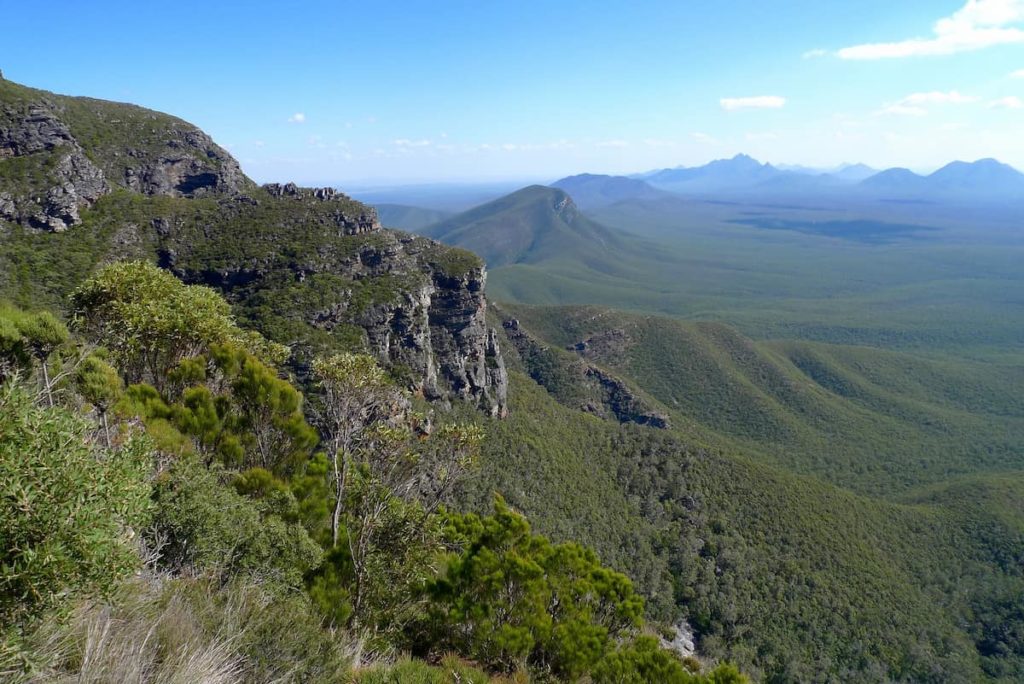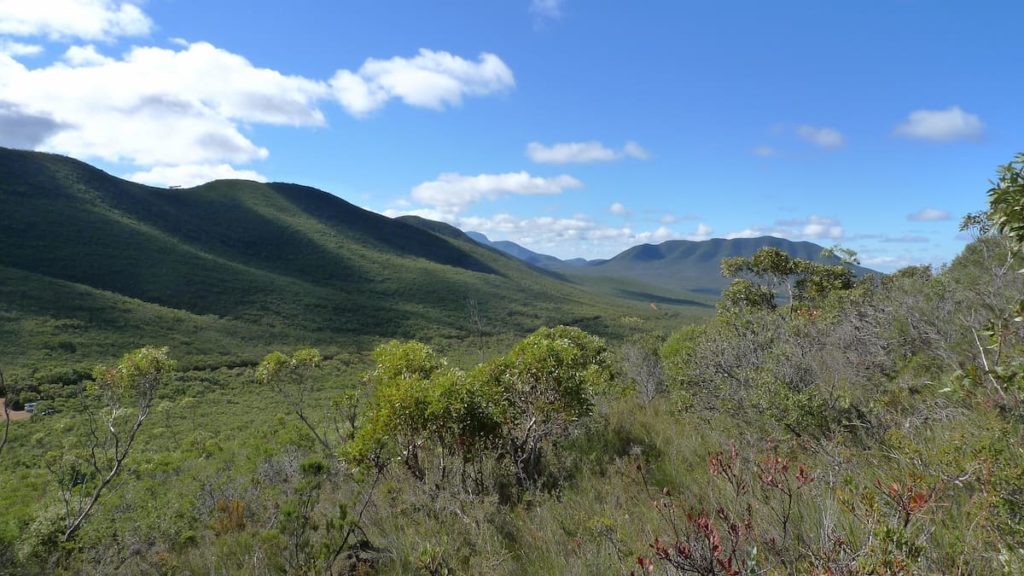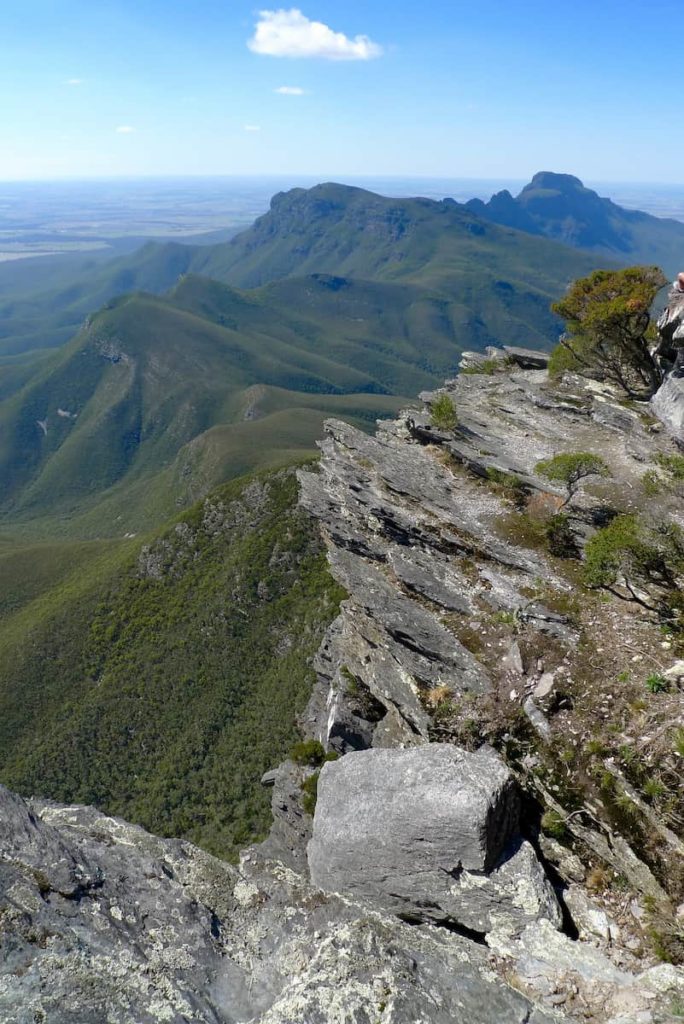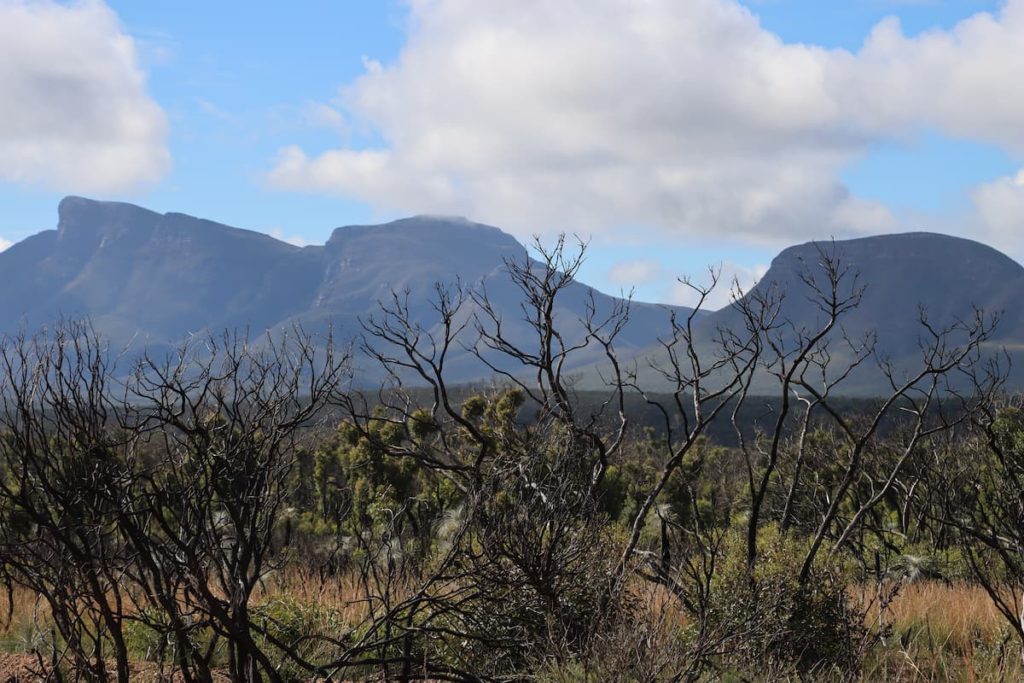Entangled nature: The Stirling Range National Park
By Andrea Gaynor [1], originally published in RCC Perspectives, (2017)
From the top of Mount Trio, the Stirling Range National Park appears covered in khaki velvet, a little threadbare in parts, but soft in the folds. Stretching up to worn peaks, the velvet tears to reveal the grey metamorphic rock beneath. The view to the west, but for the small orange spot and curved line arcing out from the base of the next peak, evokes a fantasy of timeless, ancient wilderness. Looking north or south, however, canola and wheat fields bring to mind the local and global flows of ideas, commodities, and organisms that define this place, and of which you are a part.

Image: Andrea Gaynor
Early national park advocates in Australia regarded the process of reservation as the major challenge for conservation: once a park was declared, its flora and fauna were “preserved,” and the main work lay in fending off attempted resumption for agriculture and (other) extractive industries. While advocates and politicians initially saw public health and recreation as good reasons—or convenient justifications—for park creation, concerns soon arose over the impacts of mass tourism on national park nature. Historians have subsequently portrayed the conflict between recreation and conservation as a key tension at the heart of the “national park idea.” The history of the Stirling Range National Park complicates this focus by foregrounding the entanglement of the park’s nature with diverse human activities within and around the park, as well as the non- human agents they unleashed upon it: reservation alone achieved neither ecological separation, nor ecological maintenance.
The peaks of the Stirling Range rise unexpectedly from the otherwise flat landscape of southwestern Australia. Their elevation, rock formations, and spring wildflower displays have for decades made them a popular destination for visitors seeking alpine scenery, as well as nature-lovers, bushwalkers, and rock-climbers. One of the largest reserves with-in the southwestern Australian global biodiversity hotspot, the Stirling Range National Park is today celebrated as one of the most species-rich places in Australia and valued as a significant but threatened conservation asset. The park is also part of country occupied and managed by the indigenous Noongar people and their ancestors for at least 50,000 years. Some of the peaks were avoided by Noongars; others were visited only by “clever people,” such as keepers of medical knowledge. Family groups would visit parts of the surrounding bushland seasonally to hunt game and harvest Christmas tree roots, tubers, quandong, acacia seed, yate sap, and banksia nectar. They made small conical huts for shelter, and used fire for cooking, ceremony, and perhaps also land management. The area was never a wilderness and Noongars continued to visit it even as parts were converted to pastoralism and then, in 1913, 1093 square kilometres of it was declared a national park. While the first Australian national park had been announced in New South Wales 34 years earlier, the Stirling Range National Park was distinguished by its enormity, being at the time almost three times the size of all of the national parks in Victoria put together. [2]

Image: Andrea Gaynor
To the settler society of early twentieth-century Western Australia, economic development was paramount. Yet, at this time, some elements of the state’s unique flora and fauna were increasingly valued for their beauty, scientific interest, and tourism potential. Evidence of the rarity and extinction of some species gave rise to anxiety about the state’s native nature as rapid agricultural development took place. The Under Secretary for Lands, Cecil Clifton, therefore recommended the Stirling Range reserve to the Minister for Lands on the basis that it was unsuitable for settlement and contained fine scenery as well as unique flora and fauna in urgent need of protection. [3] Nature protection at this time involved reservation against alienation for agricultural development, along with state-wide legal restrictions on activities such as hunting and wildflower picking. While a board established in 1921 under the Parks and Reserves Act “controlled” the Stirling Range National Park, little supervision took place on the ground before the first ranger was appointed in 1964. [4]
The interwar years saw considerable interest in having the park live up to its recreational, and commercial, potential, although these aims were not uncontested. In 1921 the state’s leading daily newspaper touted the park as a “splendid health resort” [5]; proposals to drive roads through it and construct a chalet in the mountains followed. This continued throughout the 1920s, as increasing emphasis was placed on both preserving and developing the state’s “natural beauties” for tourism. However, while a road to the park was opened in 1924, the park’s remoteness from Perth—around 350 kilometres away—protected it from mass tourism: in the mid-1920s, three or four large parties and as many sole visitors was a busy year for one of the main peaks.[6]

Image: Andrea Gaynor
By the 1930s, a transnational movement was seeking the declaration of “primitive areas” that would preserve wilderness in its “natural state,” devoid of human influence. In practice, this entailed opposition to economic uses such as grazing and the development of infrastructure for mass tourism. The vision was both aesthetic and scientific; however for the Stirling Range it ignored not only the long history of Noongar stewardship of the land, but also the diverse ways in which the movements and activities of people, fire, animals, and pathogens shaped the park’s ecosystems.
As the land adjacent to the park was gradually cleared for agriculture, some of the new neighbours came to see the park as a menace—a fire hazard and a haven for pest animals, including native animals such as kangaroos, emus, and wallabies. Large bushfires swept through the park in 1949/50, and by the mid-1950s landholders adjoining the park were letting fires go into the park “to protect themselves.” [7] In 1964, a visiting ornithologist noted that bushfires were frequent—probably more so since the surrounding farms were developed—and supposed that the flora was “doubtless in the process of adapting itself accordingly.” [8] In 1965 one of the local Bush Fire Brigades complained that it had been eight years since a fire had been through their section of the park, and it was “becoming extremely difficult to take a motor vehicle into the park to fight a fire, owing to the heavy regrowth of bush and scrub.” [9]
The local Bush Fire Brigades and the National Parks Board possessed neither the knowledge nor the resources to establish fire regimes that met the needs of both the park’s ecosystems and the surrounding landholders. Noongar people still camped in the area, however laws prohibiting burning of crown land, part of a broader process of dispossession, had long since disrupted any systematic Noongar fire management regime. In this context, authorities increasingly sought to manage fire in the park for the protection of human lives and property. By 1969 the National Parks Board had a policy of burning thousands of acres of the park each year, with a view to cyclically burning the entire park over a four or five year period in order to prevent large wildfires that would threaten adjoining properties. Though it is doubtful whether they had the resources to ever fully implement this policy, some local observers felt the burning was too widespread and frequent, and negatively impacted the flora and fauna. [10]
As burning increased with the creation in 1985 of a new Department of Conservation and Land Management, landholders near the park became increasingly involved in debates over fire management. In 1990 the Albany Zone Council of the Western Australian Farmers Federation held a public meeting at which participants agreed that fire management in the region should “reflect the historical and evolutionary history” of the relevant park ecosystem, namely “regular wind driven strip burning to guarantee regeneration zones for native flora and fauna.” [11] The 1999 management plan divided the park into three fire zones: one with no planned fire; one with mosaic burning for vegetation, habitat, and fuel management; and fuel reduction burning around the perimeter zone. The highest peaks, usually too moist for frequent fires, were in the “no planned fire” zone but wildfire reached them in 1991 and again in 2000. The second wildfire, occurring only nine years after the first, contributed to a major collapse in the montane vegetation, which was unable to regenerate in such a short interval. [12] Fire management in such a large area proved complex, costly, and was confounded by lightning and accidental escapes from prescribed burning.

Image: Nicole Hodgson
A general policy drawn up in 1960 charged the Western Australian National Parks Board with preserving natural beauty, conserving native flora and fauna, and protecting geological and other features of special interest in the lands under its control. At the same time, however, it required the Board to develop and improve these areas to promote their enjoyment by the public. Rising car ownership made the park more accessible and, as the director of the state’s Tourist Development Authority pointed out in 1961, “Western Australia has developed a name as the Wildflower State and every effort must be made to see that visitors to the State are not disappointed.” Though hoping to maintain some parts of the park as “primitive areas,” in the early 1960s the Board set about ex-tending the network of roads inside the park (also to serve as firebreaks) and providing camping and parking facilities. [13] The construction of a toilet block and car park at the foot of the highest peak attracted criticism on aesthetic grounds, but more significant ecological impacts—and new challenges to the park’s management—arose from the greater number and variety of people, animals, plants, and pathogens entering the park.
By 1963, busloads of tourists were visiting the park and taking away posies of wildflowers; visitors also dumped rubbish, shot kangaroos, dug up plants, and took away stone and gravel. In an area with a large number of endemic species, such activities could have serious consequences. As well as bringing in more people, the roads also provided corridors into the park that facilitated the entry of cosmopolitan animals and plants, including foxes, rabbits, and weeds. Rangers pulled weeds out by hand, while foxes would later be targeted by aircraft dropping baits containing sodium fluoroacetate (1080) poison. By the early 1970s, tyres and boots were carrying mud containing an introduced water mould, Phytophthora cinnamomi, through the park. This organism moves independently at a rate of around one metre per year and can be spread over small distances by animals, but in the Stirling Range its principal vector is humans, who can carry it long distances in soil attached to footwear, machinery, and tyres. Locally known as “dieback,” it engineers a more favourable soil environment for itself by killing susceptible vegetation. In affected areas, it radically changed the composition of the park’s flora.
Though dieback was established in the southwest jarrah forest by the mid-1960s, it took some time for researchers to understand the organism and develop measures to limit its spread. Park managers did not restrict access; and by the time CSIRO researchers formally detected dieback in the Stirling Range in 1974, it was already widespread within the park’s boundaries. The opening of gravel pits and the road construction within the park in the 1960s—probably with infested gravel—hastened the spread of dieback, as did the increasing number of bushwalkers who traversed the highest peaks without any soil hygiene management. By the 1970s, the army was using the park for training and testing troops; in return for their use of the park, army personnel assisted with management activities. [14] Army and hiking boots carried dieback to the peaks, then rainfall and gravity spread it down the slopes. As the impacts were belatedly realised, and as the rise of environmentalism fostered widespread community concern over the loss of biodiversity, in 1994 managers restricted access to parts of the park. To increase the dieback resistance of rare vegetation communities they began a programme of spraying phosphite from aircraft over small areas of the park. They also translocated some endangered plants and caged others to protect them from introduced rabbits, as well as quokkas, themselves a vulnerable native species. [15] The desire to prevent further loss of plant biodiversity to dieback called for intensified human intervention.
Over the last decade of the twentieth century, political and economic pressures to use the park as a scenic and recreational resource increased, while the rise of neoliberalism saw funding for park management and maintenance reduced. In this context, park management became ever more challenging. Conservation staff, researchers, and volunteers worked hard to protect the park’s flora and fauna; as a result, none of the park’s many endemic plant species have yet become extinct, and plant and invertebrate species new to science are still being discovered. Yet the combined forces of fire and Phytophthora have rendered the Eastern Stirling Range Montane Heath and Thicket ecosystem critically endangered. In a region that has experienced declining rainfall since the 1970s along with increasing temperatures, climate change also poses a significant threat to existing ecological communities, while hikers entering restricted areas in defiance of signage have contributed to the ongoing spread of dieback. [16]
Meanwhile, a growing number of people began to argue that native nature—in the southwest and elsewhere—was not effectively protected in fragmented reserves. Theirs was a vision of agricultural production that accommodated nature conservation and sustained ecological processes over a much larger area. Ecologists researched ways of “reintegrating fragmented landscapes.” [17] An NGO, Gondwana Link, sought to reconnect landscapes across southwestern Australia through knowledge sharing, conservation planning, and private conservation. Starting with the area between the Stirling Range and Fitzgerald River National Parks, they aimed to restore and maintain biodiversity and ecosystem function in both reserves and farmland. [18] This vision began to supplant the old model of conservation based on separate spaces for “nature” and “culture.”

Image: Andrea Gaynor
Those who fought for the establishment of national parks in Australia provided sub-sequent generations with invaluable scientific, ecological, recreational, and spiritual resources. Given the rate at which Australian ecosystems were being transformed by extractive industries in the late nineteenth and early twentieth centuries, the declaration of any national park was a triumph for conservation. However, reservation alone was insufficient for preservation, as park boundaries proved no barrier to fire, Phytophthora, animals, and climate. The nature of the Stirling Range National Park today—while still valuable in its own right—is quite different from that reserved in 1913. As the settler society forcibly took over management of the area from the Noongar people, they found their separationist paradigm of environmental protection impracticable in a more-than- human world. Their vision of nature preservation in discrete reserves and business-as- usual elsewhere was a modernist fantasy. The challenge now is to mobilise sufficient people and resources to care for this country to sustain both human livelihoods and nature’s flourishing on a bioregional scale.
Further reading
Christensen, Joseph. “An Early Western Australian Conservationist: The Romantic Figure of Jose Guillermo Hay.” Early Days: Journal and Proceedings of the Royal Western Australian Histori-cal Society 12, no. 5 (2005): 488–505.
Gissibl, Bernard, Sabine Höhler, and Patrick Kupper, eds. Civilizing Nature: National Parks in Global Historical Perspective. New York: Berghahn, 2012.
Moore, Bryce. “Tourists, Scientists and Wilderness Enthusiasts: Early Conservationists of the South West.” In Portraits of the South West: Aborigines, Women and the Environment, edited by Brian de Garis. Nedlands: UWA Press, 1993. 110–35.
Stirling Range National Park, Australian Heritage Database entry. https://www.environment.gov. au/cgi-bin/ahdb/search.pl?mode=place_detail;place_id=105818
Whatmore, Sarah. “Materialist Returns: Practising Cultural Geography in and for a More-Than- Human World.” Cultural Geographies 13, no. 4 (2006): 600–9.
End notes
[1] I would like to thank Keith Bradby and Damien Rathbone for their helpful comments on earlier drafts of this work and provision of relevant material, and Jane Davis for her assistance with the archival research.
[2] J.M. Powell, Environmental Management in Australia, 1788–1914 (Melbourne: Oxford University Press, 1976), 115.
[3] Memo from Under Secretary for Lands to Minister for Lands, 13 May 1913, Department of Lands and Surveys, “National Park—
Stirling Range,” 1908/03809, Cons. 1778, State Records Office of Western Australia (hereafter SROWA), Perth.
[4] Stirling Range and Porongorup National Parks Management Plan, 1999–2009 (Perth: Department of Conservation and Land Management for the National Parks and Nature Conservation Authority, 1999), 51.
[5] “The South-West,” West Australian, 8 February 1921, 7.
[6] Emily Pelloe, “A Wildflower Paradise,” West Australian, 19 September 1924, 14.
[7] Rev. W. A. Atkins, Extract from State Gardens Board File 1214/2, National Parks Board, “Fire Control—Stirling Range National Park,” 1942/1382 V1, Cons. 1068, SROWA.
[8] L. E. Sedgwick, “Birds of the Stirling Ranges, Western Australia,” Emu 64, no. 1 (1964): 9.
[9] Letter from Kojeneerup Bush Fire Brigade to Parks and Gardens Board, 16 September 1965, National
Parks Board, “Fire Control—Stirling Range National Park,” Cons. 1068, SROWA.
[10] Western Australian Tourist Development Authority, “Stirling Ranges—General,” 1966/177, Cons. 924, SROWA.
[11] Janette Trent to Keith Bradby, 10 April 1990, Gondwana Link Archive, Albany.
[12] Sarah Barrett and Colin J. Yates, “Risks to a Mountain Summit Ecosystem with Endemic Biota in Southwestern Australia,” Austral Ecology 40, no. 4 (2015): 423–32, doi:10.1111/aec.12199.
[13] Western Australian Tourist Development Authority, “Stirling Ranges—General,” 1966/177, Cons. 924, SROWA.
[14] Stirling Range and Porongorup National Parks Management Plan, 79.
[15] Damien Rathbone et al., “Battling the Odds,” Landscope 31, no. 3 (2016): 40–4.
[16] Phoebe Wearne, “Frontier Falls,” Albany Advertiser, 4 March 2010, 1.
[17] R. J. Hobbs and D. A. Saunders (eds.), Reintegrating Fragmented Landscapes: Towards Sustainable Production and Nature Conservation (New York: Springer Verlag, 1993).
[18] See Gondwana Link, “Stirlings to Fitzgerald,” http://www.gondwanalink.org/whatshapwhere/fitz_stirlings.
aspx. Last accessed 23 February 2017.
